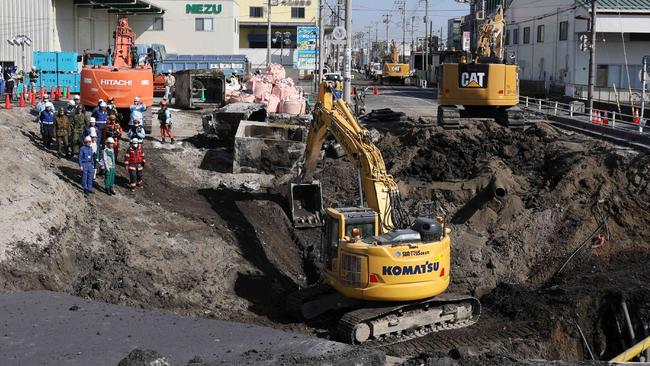The hole that gives Japan that sinking feeling
For a week, Japan has been engrossed by the strenuous, desperate and so far unsuccessful effort to save a man who disappeared into a sinkhole.

He is unnamed and faceless. All that has been made public is his age – 74 – and where he was at the fateful moment last Tuesday.
But for the past week, Japan has been engrossed by the strenuous, desperate and so far unsuccessful effort to save the man who disappeared into a sinkhole.
It began in Yashio, an unremarkable commuter town 15km north of central Tokyo. Videos show the moment at 9.50am when his two-tonne flatbed truck gently rounded a corner on a busy main road. Moments earlier, the asphalt had gaped open to expose a hole 10m wide and 7m deep into which the truck neatly toppled.
It was a sinkhole, a cavity beneath the road caused by the softening effect on the soil below the road of water from a leaking pipe. Emergency services were quickly on the scene, deploying ladders and ropes, pumps, cranes and lifting equipment. Almost a week later, they are in a worse position than they were at the start.
On the second day, set off no doubt by the vibrating machinery, a second sinkhole appeared, swallowing power poles. It quickly merged with the first, forcing the rescuers to retreat.
The water that caused the problem continues to leak – the rescuers find themselves confronted by a hole the size of a swimming pool slowly filling with sewage. Having pulled out the trailer of the truck, they have been unable to extract the cabin, in which the driver is presumed still to be. It is covered with litter and debris, and they are unable even to see inside.
Immediately after the accident, emergency workers reported being able to speak to the driver. Since then, they have heard nothing.
The apparent simplicity of the challenge adds to the sense of frustration. The saga has also revealed the complex engineering hidden beneath the country’s smooth roads.
The disaster was caused by a 3m concrete sewage pipe laid beneath Yashio in 1983. Urine and detergents in the sewage reacted to form sulphuric acid, which corroded the iron reinforcements in the concrete, breaching the pipe. The leaking sewage softened the earth beneath the road. Residents of 12 local municipalities have been asked to use as little water as possible – but clearly, it is too much to expect 1.2 million people to stop going to the toilet.
It turns out that similar decaying sewage pipes cause 2600 sinkholes nationwide every year, although most of them are less than 50cm deep.
“Such drainage pipes are all around the country, and most cities in Japan are built on soft ground,” Shinya Inazumi, a professor of engineering at the Shibaura Institute of Technology, told The Japan Times. “This is not a one-off accident. We should recognise sinkholes as a big disaster risk.”
THE TIMES


